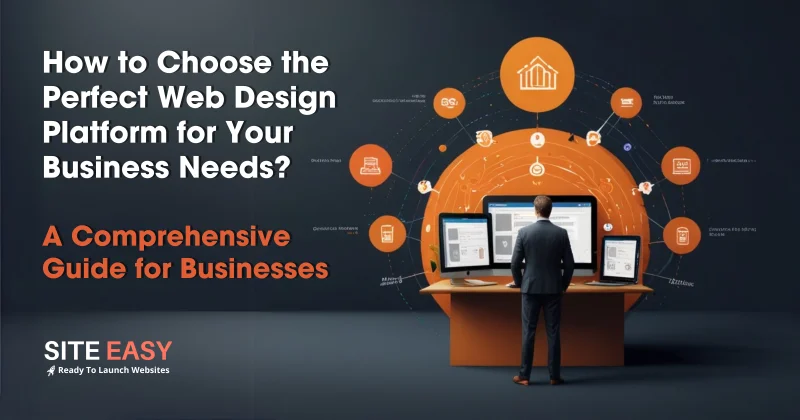How to Choose the Perfect Web Design Platform for Your Business Needs
December 11,2024
In today’s digital-first world, having a robust online presence isn’t optional—it’s essential. Whether you’re a small business owner, an entrepreneur, or an SME decision-maker, your website is often the first interaction potential customers have with your brand. Choosing the right web design platform is critical to creating an effective and visually appealing website that converts visitors into loyal customers.
This guide will walk you through the key considerations and options for selecting the perfect web design platform tailored to your unique needs.

Why Does the Right Web Design Platform Matter?
Choosing a suitable web design platform impacts several aspects of your business:
- User Experience (UX): A well-designed website enhances usability, ensuring visitors find what they’re looking for effortlessly.
- Search Engine Optimization (SEO): Platforms with built-in SEO tools make it easier to rank higher on search engines.
- Scalability: Your business will grow, and so should your website. The right platform should accommodate future needs.
- Cost-Effectiveness: The platform should provide the features you need without exceeding your budget.
Key Factors to Consider When Choosing a Web Design Platform
1. Define Your Business Goals
Your website’s purpose should guide your platform choice. Ask yourself:
- Are you building an e-commerce store?
- Do you need a portfolio site to showcase work?
- Are you a blogger or content creator?
- Is lead generation your primary goal?
2. Assess Your Technical Skills
Some platforms, like WordPress.org, require technical expertise, while others, such as Wix or Squarespace, are beginner-friendly with drag-and-drop functionality.
3. Budget Constraints
Consider initial costs, subscription fees, and long-term maintenance expenses. Open-source platforms like WordPress are cost-effective but may require hosting and additional plugins.
4. Customization and Flexibility
How much control do you need over the design and functionality? For a highly customized experience, platforms like WordPress or Webflow are ideal. For simpler needs, Wix or Shopify might suffice.
5. SEO and Marketing Tools
Ensure the platform has built-in SEO tools, such as metadata editing, mobile responsiveness, and fast loading speeds. Integrations with marketing tools like Google Analytics are also essential.
6. Scalability and Integrations
Will your platform support growth? For example, if you plan to add e-commerce functionality or a blog later, choose a platform that allows seamless integration.
7. Support and Community
Reliable customer support can save you time and stress. Additionally, platforms with active user communities provide a wealth of resources.
Popular Web Design Platforms: Pros and Cons
1. WordPress.org
Best For: Customizable and scalable websites.
Pros:
- Extensive plugins and themes.
- Full control over design and functionality.
- Excellent for SEO with plugins like Yoast SEO.
Cons:
- Requires technical knowledge.
- Self-hosted, so you’ll need to arrange hosting and security.
2. Wix
Best For: Small businesses and beginners.
Pros:
- Drag-and-drop interface.
- Hosting included.
- Free and premium plans available.
Cons:
- Limited customization compared to WordPress.
- SEO capabilities are not as robust.
3. Shopify
Best For: E-commerce businesses.
Pros:
- Built-in e-commerce features.
- Secure payment processing.
- Mobile-friendly templates.
Cons:
- Monthly subscription fees.
- Less flexible for non-e-commerce websites.
4. Squarespace
Best For: Creative portfolios and small businesses.
Pros:
- Beautiful templates.
- Hosting and domain included.
- Easy to use.
Cons:
- Limited third-party integrations.
- Higher cost.
5. Webflow
Best For: Designers and developers.
Pros:
- High level of design control.
- Responsive designs.
- Hosting included.
Cons:
- Steeper learning curve.
- More expensive than other platforms.
Real-Life Examples of Choosing the Right Platform
Case Study: E-Commerce Business
A Chennai-based SME owner looking to expand their offline store online might opt for Shopify due to its e-commerce-specific features like inventory management and secure payment gateways.
Case Study: Local Service Provider
A service-based business in Madipakkam, Chennai, might choose WordPress to create a lead-generating website with SEO optimization and blog functionality.
Redirection to Related Resources
For further insights on boosting your website’s performance, check out our blog:
- Enhance User Experience: UX Tips for SME Websites
- Improve Your Website Loading Speed: Essential Tips for SMEs
Conclusion: Make the Right Choice Today
Selecting the right web design platform is a crucial step in building a successful online presence. By understanding your goals, technical skills, budget, and scalability needs, you can find the perfect match for your business.
At Site Easy, we specialize in creating fast, user-friendly, and SEO-optimized websites tailored to your business needs. Ready to take the first step? Contact us today for a free consultation!